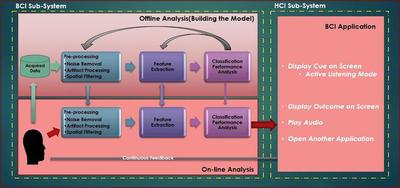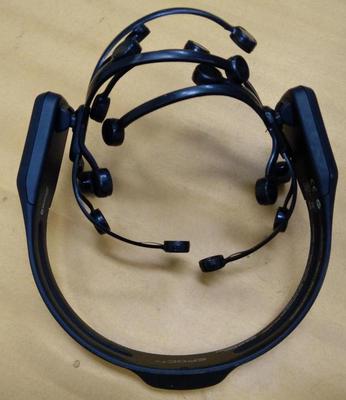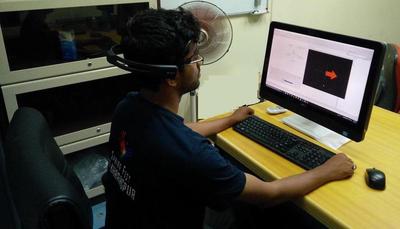BCI Augmented HCI Using EEG
 Image credit: BCI-HCI Logo IIT Kharagpur
Image credit: BCI-HCI Logo IIT Kharagpur
BCI(Brain-Computer Interface) Augmented HCI(Human Computer interactions) Using EEG
The aim of this project is to analyze and develop an application that distinguishes between intentions to move Left or Right hand and perform task based on intention. The project deals with acquiring and preprocessing of EEG signals using a 14 electrodes device. The captured signals are digitalized and transferred to the computer system. Various features set are used to classify the EEG signals accurately. These results can be used for the further development of better Brain-computer interface systems.

Key Points
Dataset generation
- Emotiv EPOC+ plus was used for data acquisition
- Data from all 16 channels (14 EEG and 2 reference) was collected
- Sampling frequency of 256 samples per second was used
- OpenViBE software was used for generating graphical cues for data acquisition

Emotive Epoch+ Device - Data was collected at BCI LAB IIT Kharagpur facility
- The data was collected in presence of a researcher, with no interaction with the subject during the recording session
- The cue(left/right arrows) displayed on a nineteen-inch monitor in random order
- The subject was relaxed, and all data acquisition was done in a well ventilated and illuminated quiet environment
- Data was collected from 15 naive subjects of age group 23 to 29 years
- 10 healthy male subjects
- 5 healthy female subjects
- Data was collected in four sessions per subject
- Each session had 25 left and 25 right hand movements recorded continuously for about 12 minutes
- Lua script was used for procedure control and to generate stimulation for data labeling

Preprocessing of the EEG signals
- The artifacts due to power line interference and other artifact above 50 Hz were easily removed using a notch filter, or a band-pass filter that allowed only signals in the range 8-30 Hz.
- The signals were recorded at 256 Hz,and to reduce computation time and Fourier Transform, they were down-sampled to 128 Hz during testing and development phase of the project.
- The optimal length of the segments for a Left or Right movement/intent to move recording was found to be 4 sec.
- CAR, ICA, CSP and Regularized CSP were major preprocessing techniques used and tested for the study.
- CSP and Regularized CSP also reduced the dimensionality from 14 channels data to just 6 channels data.
Features extracted & generated
- Autoregressive Coefficients - 20 coefficients were used
- Hilbert Transform features - transformed signal, envelope and phase
- Band Power [8-30 Hz] defined as log(1+x^2)
- Amplitude of FFT was used
Results
Voting based algorithm gave an accuracy of 88.5% along with a kappa value of 0.77